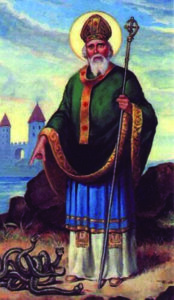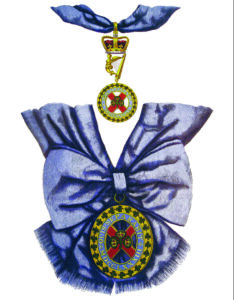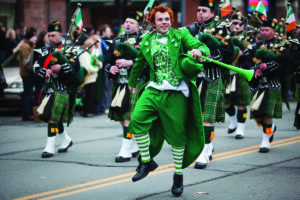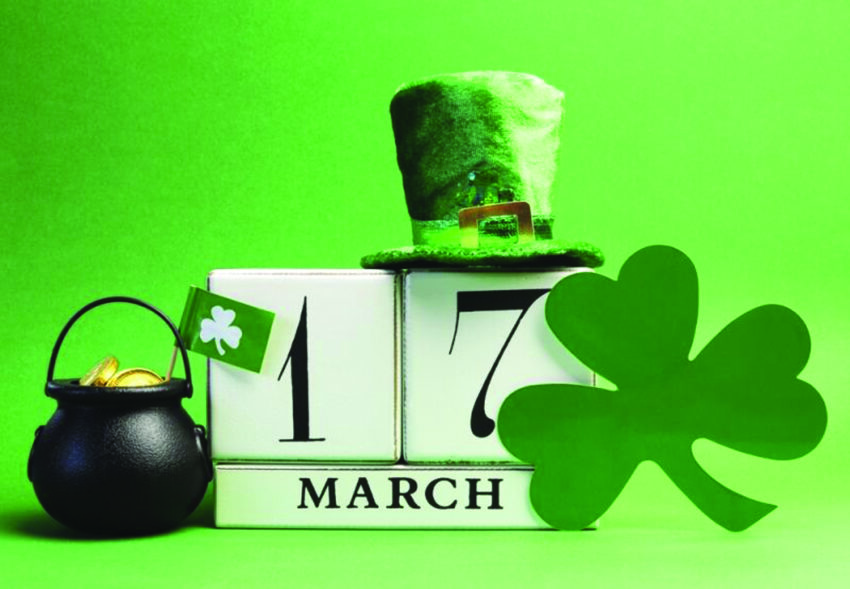Every March 17th, millions of people all over the world put on their best green attire to celebrate in honor of St. Patrick’s Day. But who was St. Patrick? To start with, St. Patrick wasn’t even Irish, and his real name given at birth was Maewyn Succat, throughout his childhood up until the time he was ordained as a priest. The beloved apostle was not born on the Emerald Isle, but that’s about all we know for sure. St. Patrick was born around the end of the 4th century in England, a part of the Britain -Roman Empire.
His story, “The Leaves of the Clover”, states that he was born in Bannavem Taberniae 386 AD, but you won’t find that city anywhere on a Britain map today. Even though experts disagree about where he was born, it may have been in England, Scotland, or Wales.
But what is clear in the Declaration, which was allegedly written by Patrick himself, is that it is believed that he was born in Roman-Britain into a wealthy Roman-British family. His father, Calphurnius, was a deacon from a Roman family of high social standing. His mother, Conchessa, was a close relative of the great patron St. Martin of Tours. St. Patrick’s grandfather, Pontius, was also a member of the clergy.
 Surprisingly, St. Patrick himself was not raised with a strong emphasis on religion. Education was not particularly stressed during his childhood, either. Even though the boy showed little or no interest in religion, soon all of that would change. Later in life, this would become a source of embarrassment for St. Patrick, who in the early 440’s would write in his book “The Confessio,” “I blush and fear exceedingly to reveal my lack of education.”
Surprisingly, St. Patrick himself was not raised with a strong emphasis on religion. Education was not particularly stressed during his childhood, either. Even though the boy showed little or no interest in religion, soon all of that would change. Later in life, this would become a source of embarrassment for St. Patrick, who in the early 440’s would write in his book “The Confessio,” “I blush and fear exceedingly to reveal my lack of education.”
When Britian withdrew its allegience from Rome because of the fall of the west, a group of Irish pirate raiders began to raid Britain. Maewyn at the age of 16 was captured by Irish pirates who brought him to Ireland, where he was sold into slavery in Dalriada. His job there was to tend sheep.
As he mastered Milchu, he became a high priest of Druidism, a Pagan sect that ruled religious influence over Ireland. In viewing his enslavement as God’s test of his faith during his six years of captivity, he became deeply devoted to Christianity through constant prayer. In a vision, he saw the children of Pagan Ireland reaching out their hands to him he grew increasingly determined to free the Irish from Druidism by converting them to Christianity.
The idea of escaping enslavement came to St. Patrick in a dream. A voice he believed to be God told him it was time to leave Ireland and that he would find passage on a ship where he could sail back home to England. Eager to see the dream materialize, St. Patrick convinced some sailors to let him board their ship to France. Lost for 28 days and covering about 200 miles of territory in the process, Maewyn at last was reunited with his family.
 Now a free man, Maewyn never lost sight of his vision and could not forget the Ireland children reaching out to him. In another dream, an angel told him he must return to Ireland and help the people as a missionary. Maewyn then went to Auxerre, France, where he studied and entered the priesthood under the guidance of the missionary St. Germain.
Now a free man, Maewyn never lost sight of his vision and could not forget the Ireland children reaching out to him. In another dream, an angel told him he must return to Ireland and help the people as a missionary. Maewyn then went to Auxerre, France, where he studied and entered the priesthood under the guidance of the missionary St. Germain.
As time passed, Pope St. Celestine I consecrated Maewyn as St. Patrick, Bishop of the Irish, so Maewyn adopted the name St. Patrick as an ordained priest and headed back to Ireland through Pope St. Celestine. Spreading “The Good News,” the Christian Gospel, to the pagans, where he was known as a prisoner, he wanted to convert a pagan Celtic culture from sun worship to Christianity. For those who worship the sun will get misfortune and will be punished for doing so. But for those who worship Christ, the true Son will be awarded.
Upon his arrival, Patrick was initially met with hostile resistance. The king and his warriors raced their chariots up to confront Patrick, and so begin a piece of magic worthy of Maewyn/St.Patrick. The Druid challenged St. Patrick, who called on God, flinging the Druid into the air to come smashing down on to the rocks. Then afterward, the King and warriors fled.
Patrick then appeared through a bolted door into the great hall of Tara. The Druid offers him a poison drink, but the drink was frozen, and he poured the drink out. Patrick was then challenged to a dual of miracles. The Druid made it snow, and Patrick made it go away, saying that the Druid can only do evil but not good.
The Druid put his coat around his young follower and Patrick put his coat around him and went inside a twig hut and set it afire. The boy survived, but the Druid’s coat burned up. The king declared it’s better to believe and instantly converted.
Afterwards, St. Patrick quickly managed to spread Christian teachings far and wide, preaching, writing, performing countless baptisms, and convincing Pagan Druids that they were worshiping idols under a belief system that kept them enslaved.
By accepting Christianity, he told them, they would be elevated to “the people of the Lord and the sons of God.” In his auobiography, “The Confession”, he wrote about converting the Irish to Christianity. While building schools and monasteries along the north and west coast, he was determined to convert Ireland to Christianity.
One famous myth is how St. Patrick drove all the snakes from Ireland. The story symbolizes a metaphor of Patrick cleansing the Island of Paganism. Though there’s just one problem. Ireland never had any snakes to begin with. The Emerald Isle is surrounded by water that was too frigid for snakes to migrate there, either from Britain or anywhere else.
According to another famous story, Patrick used the three leaves of the huge shamrock to explain the Holy Trinity of the Father, Son, and Spirit, so the Irish started wearing shamrocks on their clothing to signify their Irish Christian pride. That tradition later grew. Wearing green clothing is a popular St. Patrick’s Day custom today.
Although shamrocks don’t really exist, we know them as several three leaf plants such as wood sorrel, white clover, and yellow clover. This tradition of wearing green has become a popular Irish custom. This legend is possible, but Patrick never wrote about it.
For the next 40 years, he would travel far and wide to spread the Christian faith among the Celtic Pagan population, working miracles until his retirement to his first church.
The story of his death is an ultimate tale. Patrick requested to be taken to his beloved Armagh. Along the route, an angel appeared as in a burning bush, and a second angel requested that he return to Saul to receive his last request. As Patrick lay dying at the age of 121, the angel that visited him as a slave told him to have two untamed oxen carry his body on a cart, and where they stopped, he would be buried. Two towns claim his place of burial, but no one knows for sure but the two oxen.
You probably didn’t know that St. Patrick’s blue is still found in symbols of the state and is the color of the ribbon worn on the robes of the Knights of St. Patrick. However, the formal use of blue was first seen when Ireland was turned into a kingdom in 1542 under the reign of King Henry VIII.
Before that, Ireland was widely seen as being under the control of the Pope, who was happy to hand power to a Catholic monarch who agreed to uphold Catholic rule.
This came to an end when Henry, who was the Lord of Ireland at the time, split from Catholicism and set up his own Church of England, bringing Ireland with him and declaring it a separate kingdom.
up his own Church of England, bringing Ireland with him and declaring it a separate kingdom.
The formal creation of a new kingdom meant Ireland was granted its own coat of arms, a golden harp placed on a blue background.
England already used a dark blue, so a lighter blue was used for the Order of St Patrick. Thanks to a mixture of truth and myth passed down through the centuries, he became the superhero in the Christian church of Irish pride.
After St. Patrick died on March 17th, he was largely forgotten until mythology and legends grew. A century later, he was honored the patron saint of Ireland and the mythology surrounding his life has become ingrained in the Irish culture.
People in Ireland, since around the ninth or tenth century, have been observing the Roman Catholic feast day of St. Patrick.
So why does the holiday fall on March 17th? Supposedly, it’s the day St. Patrick died. Since then, Irish Christians have marked the day as holy. Irish Catholics would close shops to honor the feast of St. Patrick, a time for celebrations.
Since St. Patrick’s Day falls within Lent, which comes before Easter, the Catholics give up their vices as penitence. The feast of St. Patrick was the one-day reprieve when Irish men could down a pint or two of ale.
Generally it would involve public parades and festivals wearing green attire and shamrocks as well as attending church services. The Lenten restrictions on eating and drinking alcohol are lifted for the day, which has encouraged and propagated the holiday’s tradition of alcohol consumption.
But you probably didn’t know that the first St. Patrick Day parade actually started in America. The parade tradition really took off after the Potato Famine hit Ireland in the 1840’s, sending hundreds and thousands of Irish immigrants pouring into New York, Boston, and other American cities.
The first recorded St. Patrick Day Parade was in New York, 1762, when a group of Irish soldiers marched a few blocks to a tavern in lower Manhattan. Today, it’s the largest and longest, with 200,000 participants and 3,000,000 spectators each year. So this March 17th, you may find yourself wearing green and toasting to some St. Patrick history we bet you didn’t know!
